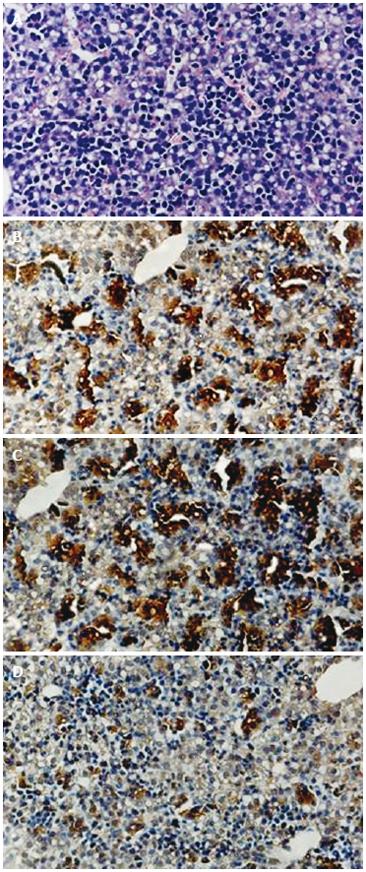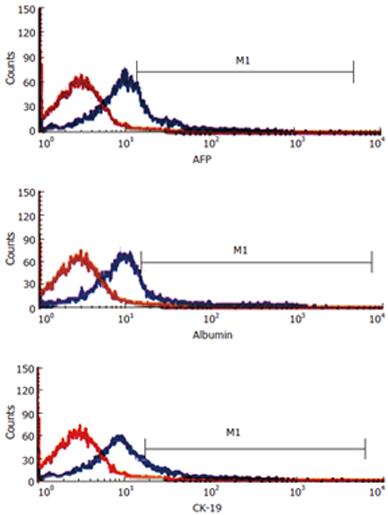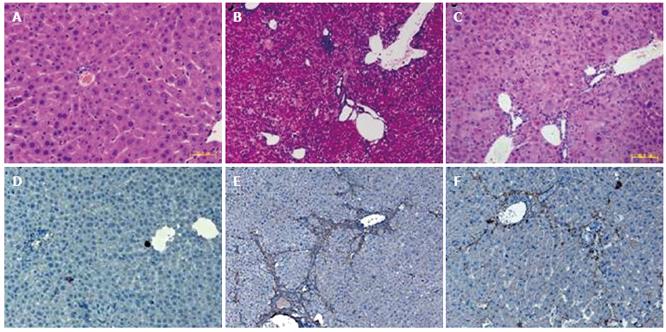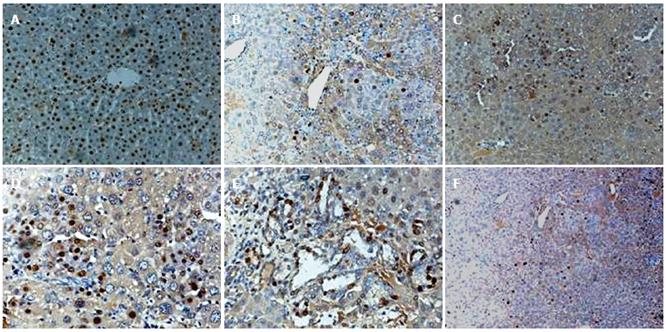Copyright
©2006 Baishideng Publishing Group Co.
World J Gastroenterol. Dec 7, 2006; 12(45): 7292-7298
Published online Dec 7, 2006. doi: 10.3748/wjg.v12.i45.7292
Published online Dec 7, 2006. doi: 10.3748/wjg.v12.i45.7292
Figure 1 Characteristics of ED 14 mouse FLEP cells.
A: Fetal liver tissue, HE staining; B: AFP, immunohistochemical staining for FLEP cells; C: Albumin, immunohistochemical staining for FLEP cells; D: CK-19, immunohistochemical staining for FLEP cells. (Original magnification, x 200).
Figure 2 Flow cytometric analysis performed on freshly isolated fetal mouse hepatocytes.
Analysis of total cells after additional labeling for AFP, albumin, and CK-19. Fetal liver contained cell populations staining positive for AFP (15.5%), Albumin (13.9%), or CK-19 (6.4%).
Figure 3 Effect of FLEP cell transplantation on liver fibrosis by HE staining and immunohistochemistry of α-SMA.
A: Normal liver tissue in control group (HE staining); B: Liver fibrosis in model group, fibrous tissue was formed with inflammatory cell infiltration in liver (HE staining); C: Liver fibrosis in FLEP cell transplantation group. The pathological change of liver was rather lighter compared with the model group (HE staining). D: Normal liver tissue, only α-SMA expression of vascular smooth muscle cell (immunohistochemical staining); E: Liver tissue in model group, displaying an increased amount of α-SMA expression with a dense network (immunohistochemical staining); F: Liver tissue in FLEP cell transplantation group, α-SMA expression was reduced compared with the model group (immunohistochemical staining). (original magnification, × 200).
Figure 4 Proliferation and differentiation of FLEP cells in DEN-treated mice and normal mice.
A: Immunohistochemical positive control staining for sry protein; normal male mouse liver with nuclear positivity in the majority of hepatocytes (brown nuclei); B: One month after FLEP cell transplantation and DEN treatment, some cells stained for sry. C: Two months after FLEP cell transplantation and DEN treatment, sry+ cells were present in liver parenchyma. D and E: Three months after FLEP cell transplantation and DEN treatment, sry+ cells formed numerous mature hepatocytes showed canalicular structures (D), or bile duct epithelial cells in bile duct region, as evidenced by diffusely stained sry+ small epithelial cells in bile duct-like structures (E); F: Three months after FLEP cell transplantation without DEN treatment, scattered sry+ cells were observed. Original magnifications, x 200 (A-E) and x100 (D).
- Citation: Zheng JF, Liang LJ, Wu CX, Chen JS, Zhang ZS. Transplantation of fetal liver epithelial progenitor cells ameliorates experimental liver fibrosis in mice. World J Gastroenterol 2006; 12(45): 7292-7298
- URL: https://www.wjgnet.com/1007-9327/full/v12/i45/7292.htm
- DOI: https://dx.doi.org/10.3748/wjg.v12.i45.7292
















